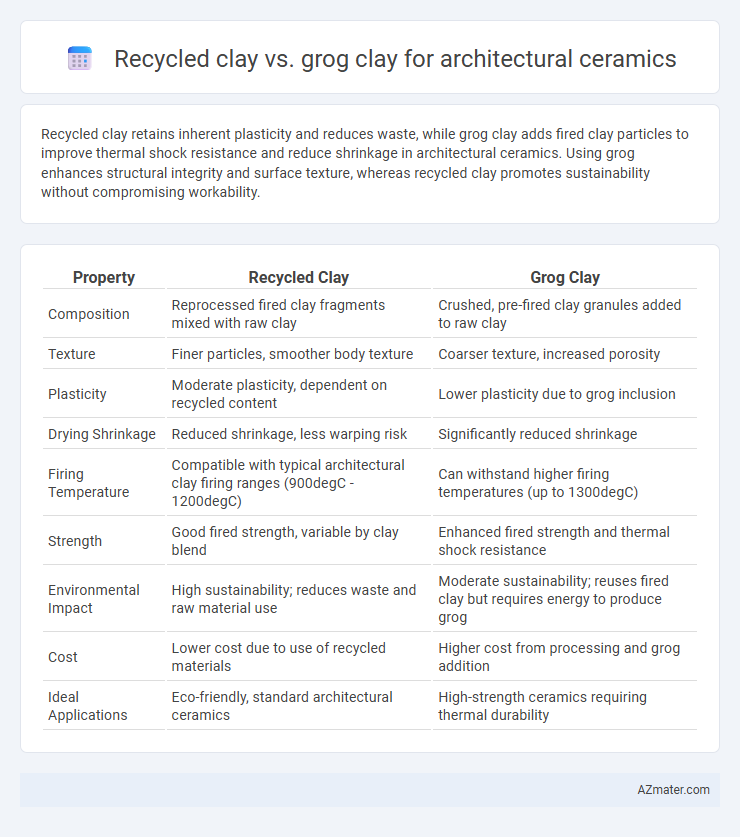Recycled clay retains inherent plasticity and reduces waste, while grog clay adds fired clay particles to improve thermal shock resistance and reduce shrinkage in architectural ceramics. Using grog enhances structural integrity and surface texture, whereas recycled clay promotes sustainability without compromising workability.
Table of Comparison
| Property | Recycled Clay | Grog Clay |
|---|---|---|
| Composition | Reprocessed fired clay fragments mixed with raw clay | Crushed, pre-fired clay granules added to raw clay |
| Texture | Finer particles, smoother body texture | Coarser texture, increased porosity |
| Plasticity | Moderate plasticity, dependent on recycled content | Lower plasticity due to grog inclusion |
| Drying Shrinkage | Reduced shrinkage, less warping risk | Significantly reduced shrinkage |
| Firing Temperature | Compatible with typical architectural clay firing ranges (900degC - 1200degC) | Can withstand higher firing temperatures (up to 1300degC) |
| Strength | Good fired strength, variable by clay blend | Enhanced fired strength and thermal shock resistance |
| Environmental Impact | High sustainability; reduces waste and raw material use | Moderate sustainability; reuses fired clay but requires energy to produce grog |
| Cost | Lower cost due to use of recycled materials | Higher cost from processing and grog addition |
| Ideal Applications | Eco-friendly, standard architectural ceramics | High-strength ceramics requiring thermal durability |
Introduction to Architectural Ceramics
Recycled clay and grog clay serve distinct roles in architectural ceramics, impacting durability and texture in construction applications. Recycled clay, made from reprocessed ceramic scraps, offers sustainability benefits by reducing waste and energy consumption during production. Grog clay, containing pre-fired clay particles, enhances mechanical strength and thermal shock resistance, making it ideal for structural components in architectural projects.
Understanding Recycled Clay
Recycled clay in architectural ceramics involves reprocessing clay scraps and broken fired pieces to reduce waste and lower material costs while maintaining workable plasticity and strength. Unlike grog clay, which contains pre-fired clay particles added to improve thermal shock resistance and reduce shrinkage, recycled clay emphasizes sustainability by reintroducing used materials into the production cycle. Properly processed recycled clay retains critical physical properties, making it a viable environmentally-friendly option without compromising the ceramic's durability or performance.
What is Grog Clay?
Grog clay is a type of ceramic clay mixed with pre-fired and crushed clay particles called grog, which enhances durability and thermal shock resistance in architectural ceramics. The inclusion of grog improves the clay's structural integrity and reduces shrinkage during firing, making it ideal for heavy-duty clay work like bricks and tiles. Compared to recycled clay, grog clay offers a more stable and consistent texture that supports precise architectural detailing.
Material Composition and Properties
Recycled clay for architectural ceramics typically contains a mixture of reclaimed clay particles, organic matter, and fine impurities that enhance plasticity but may reduce firing strength compared to grog clay. Grog clay includes pre-fired, crushed ceramic material that improves thermal shock resistance, reduces shrinkage, and increases mechanical strength by adding coarse, inert particles. The choice between recycled clay and grog clay affects workability, drying behavior, and fired durability, with grog clay favored for structural integrity and recycled clay for sustainability and enhanced moldability.
Workability and Handling Differences
Recycled clay often retains higher plasticity and moisture content, enhancing workability for architectural ceramics compared to grog clay, which includes pre-fired material that reduces shrinkage but increases rigidity and abrasiveness. Grog clay improves structural integrity and reduces cracking risk but requires more effort during shaping and handling due to its coarse texture. The choice between recycled and grog clay balances ease of manipulation with durability, impacting precision in large-scale ceramic construction projects.
Firing Results and Durability
Recycled clay in architectural ceramics often exhibits higher porosity and lower mechanical strength after firing compared to grog clay, which contains pre-fired, crushed ceramic particles that enhance thermal shock resistance and dimensional stability. Grog clay's inclusion improves firing results by reducing shrinkage and cracking, resulting in more durable and structurally sound ceramic components. The durability of grog clay ceramics surpasses recycled clay alternatives, making them preferable in applications requiring long-term resilience and weather resistance.
Aesthetic Outcomes: Texture and Surface Finish
Recycled clay offers a smoother texture with subtle natural variations that enhance the aesthetic warmth of architectural ceramics, while grog clay introduces a rougher, more tactile surface finish due to its granular inclusions. Grog particles improve surface durability and provide a distinctive speckled or textured appearance, making it ideal for rustic or industrial design styles. The choice between recycled clay and grog clay significantly impacts the visual and tactile qualities of ceramic facades, influencing both artistic expression and functional appeal.
Environmental Impact and Sustainability
Recycled clay significantly reduces landfill waste and lowers energy consumption by reusing materials from previous ceramic productions, promoting a circular economy in architectural ceramics. Grog clay, composed of pre-fired clay particles, enhances durability and reduces shrinkage, which minimizes material waste during firing but requires initial energy-intensive processing. Both materials contribute to sustainability by decreasing raw material extraction and supporting eco-friendly ceramic manufacturing practices.
Cost Considerations for Large-Scale Projects
Recycled clay significantly reduces material costs for large-scale architectural ceramic projects by reusing waste clay and minimizing raw material purchases. In contrast, grog clay, containing pre-fired clay particles, often incurs higher expenses due to the energy-intensive processing required to create grog additives. The choice between recycled and grog clay directly impacts budgeting, with recycled clay offering a more sustainable and economical option for extensive production runs.
Choosing the Right Clay for Architectural Applications
Recycled clay offers sustainability benefits through reduced waste and lower energy consumption, making it an eco-friendly option for architectural ceramics. Grog clay enhances structural integrity by incorporating pre-fired clay particles, improving thermal shock resistance and reducing shrinkage during firing. Selecting the right clay depends on balancing environmental impact with performance requirements such as durability, workability, and thermal stability for long-lasting architectural elements.

Infographic: Recycled clay vs Grog clay for Architectural ceramic
 azmater.com
azmater.com